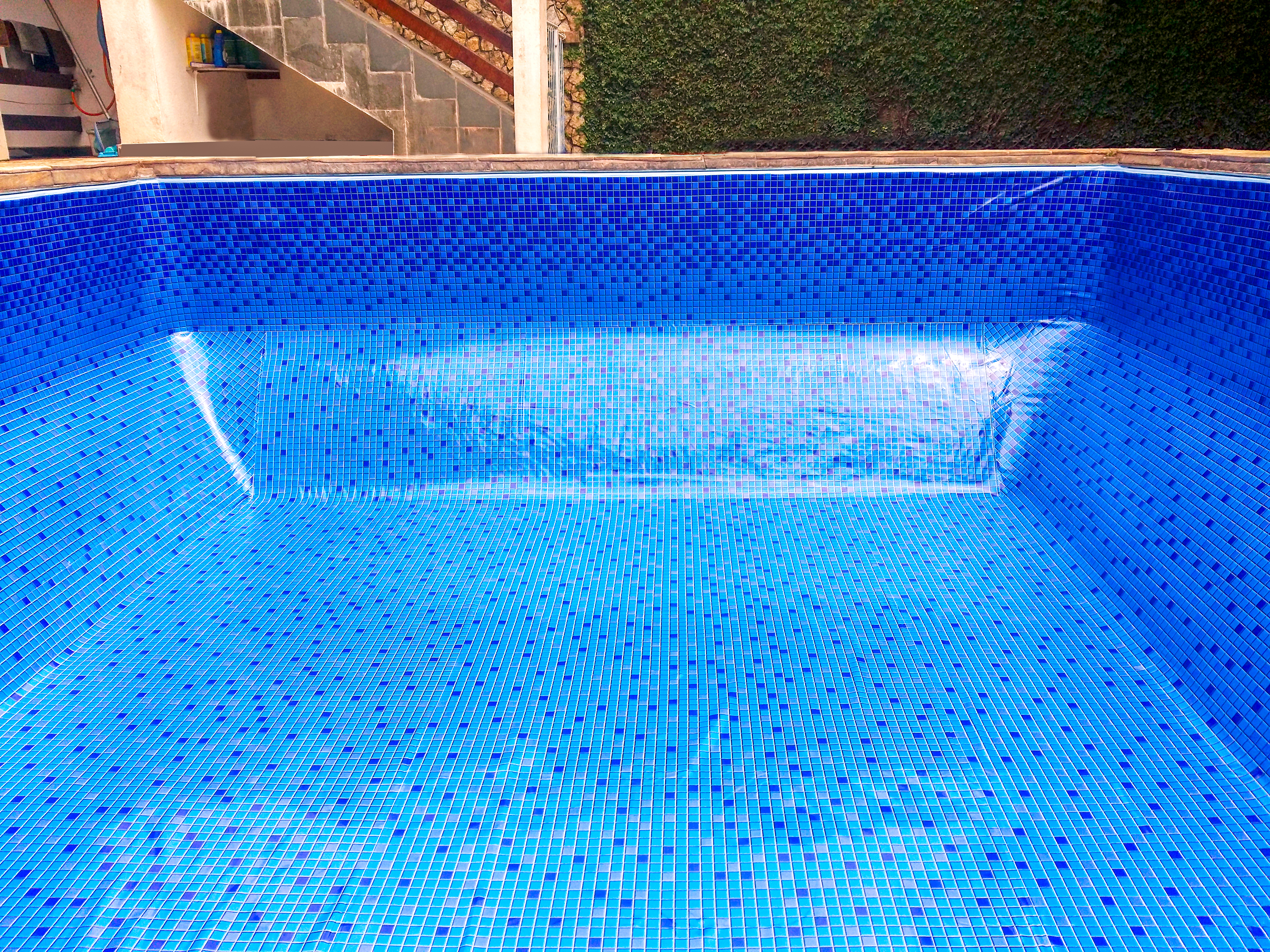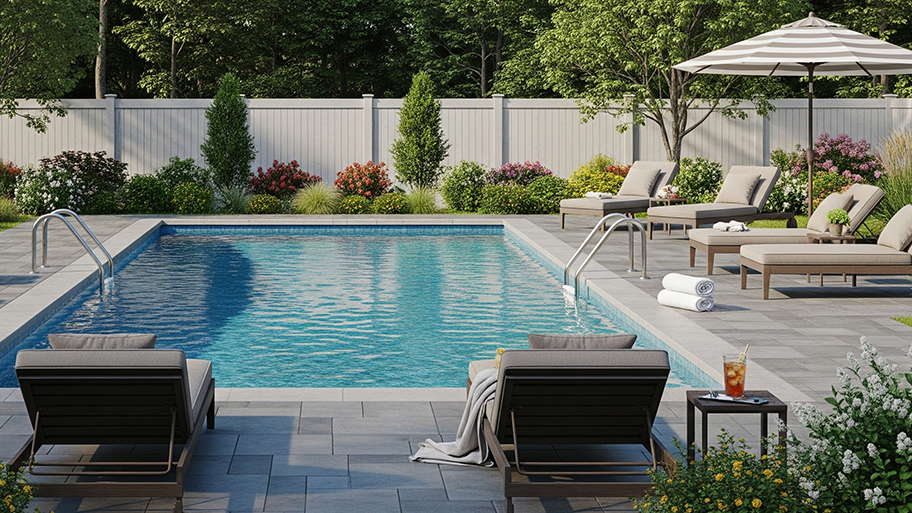
If you’ve been considering installing a new pool in the Buckeye State, this guide will help you understand inground pool costs in Columbus.
There’s more than one way to heat a pool


As spring begins, the first warm ray of sunshine might have you itching to open up the pool. Luckily, you have several options for how to heat your pool. Some are affordable short-term solutions, while others are long-term investments. Here are eight tips to help you take advantage of all your heating options, whether or not you have a pool heater.

Heating a pool doesn’t have to be expensive if you allow the earth’s elements to assist you. Simply letting your sun soak up the rays increases the temperature by 0.7 degrees per hour of full sunlight, but there are plenty of solar pool covers that work harder and faster to capture the sun’s heat:
Solar Pool Covers: Also called solar blankets, solar pool covers form a barrier between the water and the sun, absorbing heat. They can increase the pool’s temperature by up to 15 degrees and prevent 95% of evaporation. Note, though, that you won’t be able to swim unless you take the cover off.
Liquid Solar Pool Covers: These covers are a fatty alcohol substance that forms an invisible barrier on the pool’s surface to prevent evaporation. It’s biodegradable, non-toxic, and affordable, but it doesn’t fare well in windy climates or vigorous swimming, which could break the seal.
Solar Dome: This dome-shaped pool cover consists of vinyl and aluminum closings that effectively turn your outdoor pool into an indoor one. Its clear material allows sunlight to enter while preventing heat from escaping.
Solar Rings: Though this wireless solar pool heating option may look like a pool toy, it’s actually made of disc-shaped UV-resistant vinyl that keeps out coolness, draws in sunlight, and stores heat. Each solar ring is only about 2 feet in diameter, but you don’t need more than a few to feel the effects on your pool.
Another way to keep your pool comfortable without using a heater—or to use it less—is to build an enclosure. Because wind is one of the major factors in cooling your pool water, building a windproof enclosure will cut down on any energy costs associated with running a heater.
Your pool enclosure costs will depend on the type of enclosure you choose and how elaborate your design is. Still, many deem this a worthwhile expense because you can use the pool at any time of year, regardless of weather or temperature. A more affordable method to combat the wind is to install a windscreen fence around the pool.
If you’ve exhausted all your options and are still finding your pool water a little too cold for comfort, you may need a more heavy-duty option, like a heat pump, gas or propane heater, or solar-powered heater.
Here’s a breakdown of different types of pool heaters.
| Heater Type | Average Installation Cost | Best For |
|---|---|---|
| Solar | $3,000–$4,000 | Energy efficiency and homes with ample space |
| Gas or propane | $1,500–$6,000 | Lower installation costs and quick heating |
| Heat pump | $2,500–$7,500 | Energy efficiency and minimal maintenance |
| Electric resistance | $2,000–$5,000 | Smaller pools and lower installation costs |
No heating method will work in a pool that’s not insulated. The ground surrounding your pool will always be cooler than your desired water temperature. To properly insulate an in-ground pool, install a rigid panel insulation around the pool base. This will allow less heat to escape and reduce your energy costs.
On the flip side, insulating an aboveground pool will require a bit more work because you’ll need to redo it each time you go for a swim. Cover the water with a surface blanket that fits the dimensions of your pool, then tie ropes to the edges of the pool to secure it from windy and rainy conditions to ensure as little heat as possible escapes.
Everyone has a different ideal water temperature for a comfortable swim, but setting the thermostat too high can result in overwhelming expenses. It’s easy for a small hot tub to maintain temperatures above 80 degrees, but maintaining that level in an average-sized pool would cost a small fortune.
For every degree bump you set, you’ll incur an extra 15% and 18% in operating costs. To save costs, only run your heater when you plan to use the pool or set it lower after you’ve finished swimming.
For most people, a comfortable swimming temperature ranges between 78 to 82 degrees Fahrenheit. If installing a heater, talk to your electrician or pool contractor about how this may impact your electrical bill.
As with any other appliance that burns fuel, you should have your gas or propane pool heater serviced regularly by a local pool heater pro—once a year on average. Though you’ll pay for the maintenance, you’ll enjoy more long-term savings using a highly efficient, longer-lasting system.
The better your pool pump and filtration systems work, the more efficient your heating efforts will be. In the long run, paying to install the best mechanical systems and maintaining them will save you on heating costs.
If you have a smaller pool, you don’t need to buy a fancy solar dome or install solar panels—the black hose trick can warm pool water at bargain basement costs. All you need is a thick black garden hose.
To create a DIY solar pool heater, connect the hose to your tap and leave it in a spot that receives abundant direct sunlight. Wrap the hose up like a coil in the middle of that bright patch, leaving enough slack for the spout to reach the pool. After the hose heats in the sun, turn it on and run warm water into the pool.

Some of the best ways to save on pool heating costs are maintaining proper pool insulation and having your heater serviced regularly—both allow the heating method to operate at its best. Here are a few other tips for lowering costs while keeping your pool summery:
Run your pool pump during the warmest parts of the day to circulate warm water.
Clean the pool filter regularly so the heating system works more efficiently by improving water flow.
Cover the pool at night to retain heat when temperatures drop.
Keep the pool area free from obstructions like overhanging branches that cast shade.
I had Ace Fireplace Services install custom chimney caps for my home, and the results are stunning. They fit like a glove and have added a touch of sophistication to my chimney. I can't recommend their services enough.
I first met Ilia when windows were installed on my new back porch. He was extremely conscientious about getting the job done right and it was. Now I ve had all the windows of two levels of my house completed by him.....ON TIME, ON BUDGET, TO MY TOTAL SATISFACTION. I'm a happy customer.
AFS was excellent from start to finish. Jess, the sales associate, was fantastic...very knowledgeable and very professional. The installation crew was excellent. I couldn't be more pleased with the process. Best of all, my new floor looks fantastic!
They did a great job and were easy to work with. They thinned the trees out while leaving a pleasing shape and setting them up for the next several years. They cleaned everything up and couldn't have been nicer.
I've been around the block myself many times and know most of the lingo, angles, tricks and traps of contracting work on a home. And, I've taken the community school contracting licensing classes and heard contractors discuss openly and candidly trade practices and tales both good and bad. ...
Everyone I talked to at the company, including the people on the phone and the installers, were courteous and polite. All my contact with them has been good. If people like that worked at AT&T, they would make more money. With me and the people on the phone and with the installers, there was...
From average costs to expert advice, get all the answers you need to get your job done.

If you’ve been considering installing a new pool in the Buckeye State, this guide will help you understand inground pool costs in Columbus.

Is it time to treat yourself to backyard pool parties and late-night swims? Start with our guide, which answers the question: how much does it cost to build a pool?

The cost of pool liner replacement in Columbus depends on the size and shape of your pool, as well as the liner material and type. Here’s how the costs break down.

A pool liner can protect your pool from leaks and improve its appearance. Learn more about the different types of pool liners and which is right for your pool.

Everything was going swimmingly, but now your pool heater is not working properly. Here are some troubleshooting tips to get you back in business.

If you own a pool, you may wonder: how many gallons in my pool? Read on for our pool volume calculator to learn how much water is in your swimming pool.